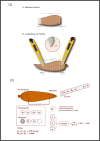A method for rapid and homogenous initiation of post-harvest physiological deterioration in cassava storage roots identifies Indonesian cultivars with improved shelf-life performance
- PMID: 36653871
- PMCID: PMC9847153
- DOI: 10.1186/s13007-022-00977-w
A method for rapid and homogenous initiation of post-harvest physiological deterioration in cassava storage roots identifies Indonesian cultivars with improved shelf-life performance
Abstract
Cassava is the most cultivated and consumed root crop in the world. One of the major constraints to the cassava value chain is the short shelf life of cassava storage roots which is primarily due to the so-called post-harvest physiological deterioration (PPD). The identification of natural sources of PPD tolerance represents a key approach to mitigating PPD losses by generating farmer- and industry-preferred cassava cultivars with prolonged shelf life. In the present study, a PPD assessment method was developed to screen for PPD tolerance in the cassava germplasm. The proposed PPD assessment method displayed a reduced rate of microbial infection and allowed a rapid and homogenous development of typical PPD symptoms in the cassava storage roots. We successfully used the PPD assessment method in combination with an image-based PPD scoring method to identify and characterize PPD tolerance in 28 cassava cultivars from the Indonesian cassava germplasm. Our analysis showed a significant and positive correlation between PPD score and dry matter content (r = 0.589-0.664, p-value < 0.001). Analysis of additional root parameters showed a significant and positive correlation between PPD scores at 2 days post-harvest (dph) and root length (r = 0.388, p-value < 0.05). Our analysis identified at least 4 cultivars displaying a significantly delayed onset of PPD symptoms as compared to the other selected cultivars. The availability of cassava cultivars contrasting for tolerance to PPD will be particularly instrumental to understanding the molecular mechanisms associated with delayed PPD in cassava roots.
Keywords: Cassava germplasm; PPD assessment.
© 2023. The Author(s).
Conflict of interest statement
The authors declare that they have no conflict of interest.
Figures







References
-
- Balitkabi. (2017). Pendekatan Baru Pemanfaatan Ubi Kayu untuk Industri Makanan Indonesia. http://balitkabi.litbang.pertanian.go.id/berita/pendekatan-baru-pemanfaa...
-
- Beyene G, Chauhan RD, Gehan J, Siritunga D, Taylor N. Cassava shrunken-2 homolog MeAPL3 determines storage root starch and dry matter content and modulates storage root postharvest physiological deterioration. Plant Mol Biol. 2022;109(3):283–299. doi: 10.1007/s11103-020-00995-z. - DOI - PMC - PubMed
-
- Booth RH. Cassava storage post-harvest deterioration and storage of fresh cassava roots. Colombia: CIAT; 1975.
-
- Buschmann H. Accumulation of hydroxycoumarins during post-harvest deterioration of tuberous roots of Cassava (Manihot esculenta Crantz) Ann Bot. 2000;86(6):1153–1160. doi: 10.1006/anbo.2000.1285. - DOI
LinkOut - more resources
Full Text Sources

